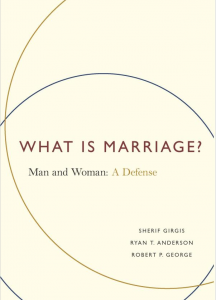 The second chapter of What is Marriage? sets forth the authors’ rationale for their view of conjugal marriage, which they further define as “Comprehensive Union.” Comprehensive union is grounded in biological and social realities: without bodily union, a relationship cannot be considered “comprehensive” even if it includes other aspects such as companionship and common domestic life. Further, just as the organs of one’s body are coordinated for the single biological purpose of the whole that they form together, just so “for two individuals to unite organically, their bodies must coordinate toward a common biological end of the whole that they form together” (25, original emphasis).
The second chapter of What is Marriage? sets forth the authors’ rationale for their view of conjugal marriage, which they further define as “Comprehensive Union.” Comprehensive union is grounded in biological and social realities: without bodily union, a relationship cannot be considered “comprehensive” even if it includes other aspects such as companionship and common domestic life. Further, just as the organs of one’s body are coordinated for the single biological purpose of the whole that they form together, just so “for two individuals to unite organically, their bodies must coordinate toward a common biological end of the whole that they form together” (25, original emphasis).
There is one respect in which this highest kind of bodily unity is possible between two individuals, one function for which a mate really does complete us: sexual reproduction. In coitus, and there alone, a man and a woman’s bodies participate by virtue of their sexual complementarity in a coordination that has the biological purpose of reproduction—a function that neither can perform alone. … Here the whole is the couple; the single biological good, their reproduction (26, original emphasis).
The authors note that it is this coordination toward procreation which makes the union, not the achievement of procreation in itself. Comprehensive union is of value in itself, and not simply as a means to an end. Because it has a unitive as well as a procreative function, the failure to conceive a child does not invalidate the bodily coordination.
Because marriage is uniquely ordered to having and raising children, marriage calls for the wide-ranging co-operation of a shared domestic life to support that end: “the demands of marriage are shaped by those of parenting” (28). Again, the argument is not “that the relationship of marriage and the comprehensive good of rearing children always go together. It is that, like a ball and socket, they fit together: that family life specially enriches marriage; that marriage is especially apt for family life, which shapes its norms” (29, original emphasis). Procreation is the good that fulfils and extends a marriage because it fulfils and extends the act that embodies or consummates the commitment of marriage: the same act by which spouses make love also makes new life; it both seals the marriage and brings forth children (30).
The authors continue to use the biological complementarity of the male and female, and the organic analogy to argue for permanence and sexual exclusivity as norms which characterise the marital relation; comprehensive union requires comprehensive commitment. Marriage is possible only between two because no act can organically (bodily) unite three or more parties. The raising of children and establishing of family is an open-ended task calling for whole-of-life commitment and coordination which in turn requires undivided commitment. Divorce and infidelity undermine the stability conducive to this task and commitment. Because the conjugal view of marriage understands it as distinguished by bodily union and its natural fulfillment in children and family life, it is able to make sense of a pledge to sexual exclusivity, which the revisionist view finds difficult to explain (33-34).
An account of marriage must explain what makes the marital relationship different from others. In our view, the kind of union created by consent to marriage is uniquely comprehensive in how it unites persons, what it unites them with respect to, and how extensive a commitment it demands. … In short, as most people acknowledge, marriage involves a bodily as well as mental union of spouses, a special link to children and domestic life, and permanent and exclusive commitment. All three elements converge in, and go to constitute, the conjugal view (35-36, original emphasis).
Continued Soon…